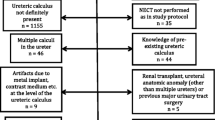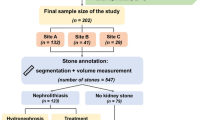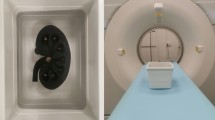Abstract
Objectives
The size estimation in CT images of an obstructing ureteral calculus is important for the clinical management of a patient presenting with renal colic. The objective of the present study was to develop a reader independent urinary calculus segmentation algorithm using well-known digital image processing steps and to validate the method against size estimations by several readers.
Methods
Fifty clinical CT examinations demonstrating urinary calculi were included. Each calculus was measured independently by 11 readers. The mean value of their size estimations was used as validation data for each calculus. The segmentation algorithm consisted of interpolated zoom, binary thresholding and morphological operations. Ten examinations were used for algorithm optimisation and 40 for validation. Based on the optimisation results three segmentation method candidates were identified.
Results
Between the primary segmentation algorithm using cubic spline interpolation and the mean estimation by 11 readers, the bias was 0.0 mm, the standard deviation of the difference 0.26 mm and the Bland–Altman limits of agreement 0.0 ± 0.5 mm.
Conclusions
The validation showed good agreement between the suggested algorithm and the mean estimation by a large number of readers. The limit of agreement was narrower than the inter-reader limit of agreement previously reported for the same data.
Key Points
-
The size of kidney stones is usually estimated manually by the radiologist.
-
An algorithm for computer-aided size estimation is introduced.
-
The variability between readers can be reduced.
-
A reduced variability can give better information for treatment decisions.



Similar content being viewed by others
References
Dalrymple NC, Verga M, Anderson KR, Bove P, Covey AM, Rosenfield AT, Smith RC (1998) The value of unenhanced helical computerized tomography in the management of acute flank pain. J Urol 159:735–740
Türk C, Knoll T, Petrik A, Sarica K, Seitz C, Straub M, Traxer O (2010) Guidelines on Urolithiasis. European association of urology, Arnhem. Available via http://www.uroweb.org/gls/pdf/Urolithiasis%202010.pdf. Accessed 15 Oct 2010
Coll DM, Varanelli MJ, Smith RC (2002) Relationship of spontaneous passage of ureteral calculi to stone size and location as revealed by unenhanced helical CT. AJR Am J Roentgenol 178:101–103
Preminger GM, Tiselius H, Assimos DG, Alken P, Buck AC, Gallucci M, Knoll T, Lingeman JE, Nakada SY, Pearle MS, Sarica K, Türk C, Wolf JS Jr (2007) 2007 Guideline for the management of ureteral calculi. Eur Urol 52:1610–1631
Lidén M, Andersson T, Geijer H (2011) Making renal stones change size-impact of CT image post processing and reader variability. Eur Radiol 21:2218–2225
Demehri S, Kalra MK, Rybicki FJ, Steigner ML, Lang MJ, Houseman EA, Curhan GC, Silverman SG (2011) Quantification of urinary stone volume: attenuation threshold-based CT method–a technical note. Radiology 258:915–922
Gonzales RC, Woods RE (2001) Digital Image Processing, 2nd edn. Prentice Hall Inc, Upper Saddle River, New Jersey
Bland JM, Altman DG (1986) Statistical methods for assessing agreement between two methods of clinical measurement. Lancet 1:307–310
Agatston AS, Janowitz WR, Hildner FJ, Zusmer NR, Viamonte MJ, Detrano R (1990) Quantification of coronary artery calcium using ultrafast computed tomography. J Am Coll Cardiol 15:827–832
Kishore TA, Pedro RN, Hinck B, Monga M (2008) Estimation of size of distal ureteral stones: noncontrast CT scan versus actual size. Urology 72:761–764
Eisner BH, Kambadakone A, Monga M, Anderson JK, Thoreson AA, Lee H, Dretler SP, Sahani DV (2009) Computerized tomography magnified bone windows are superior to standard soft tissue windows for accurate measurement of stone size: an in vitro and clinical study. J Urol 181:1710–1715
Kambadakone AR, Eisner BH, Catalano OA, Sahani DV (2010) New and evolving concepts in the imaging and management of urolithiasis: urologists’ perspective. Radiographics 30:603–623
Berkovitz N, Simanovsky N, Katz R, Salama S, Hiller N (2010) Coronal reconstruction of unenhanced abdominal CT for correct ureteral stone size classification. Eur Radiol 20:1047–1051
Metser U, Ghai S, Ong YY, Lockwood G, Radomski SB (2009) Assessment of urinary tract calculi with 64-MDCT: The axial versus coronal plane. AJR Am J Roentgenol 192:1509–1513
Nadler RB, Stern JA, Kimm S, Hoff F, Rademaker AW (2004) Coronal imaging to assess urinary tract stone size. J Urol 172:962–964
Lin W, Uppot RN, Li C, Hahn PF, Sahani DV (2007) Value of automated coronal reformations from 64-section multidetector row computerized tomography in the diagnosis of urinary stone disease. J Urol 178:907–911
Patel U, Walkden RM, Ghani KR, Anson K (2009) Three-dimensional CT pyelography for planning of percutaneous nephrostolithotomy: accuracy of stone measurement, stone depiction and pelvicalyceal reconstruction. Eur Radiol 19:1280–1288
Acknowledgements
We thank T. Eriksson for assisting in selecting the cases and the participating readers at the radiology department: T. Birgersson, P. Dimitriou, T. Eriksson, A. Gregorius, J. Jendeberg, W. Krauss, M. Lundin, A. Mood, H. Skoglund and T. Westermark.
This work has been conducted in collaboration with the Center for Medical Image Science and Visualization (CMIV) at Linköping University, Sweden. CMIV is acknowledged for the provision of financial support and for providing leading-edge research infrastructure. The study was funded in part by a grant from The Knowledge Foundation, Stockholm, Sweden.
Author information
Authors and Affiliations
Corresponding author
Rights and permissions
About this article
Cite this article
Lidén, M., Andersson, T., Broxvall, M. et al. Urinary stone size estimation: a new segmentation algorithm-based CT method. Eur Radiol 22, 731–737 (2012). https://doi.org/10.1007/s00330-011-2309-x
Received:
Revised:
Accepted:
Published:
Issue Date:
DOI: https://doi.org/10.1007/s00330-011-2309-x




